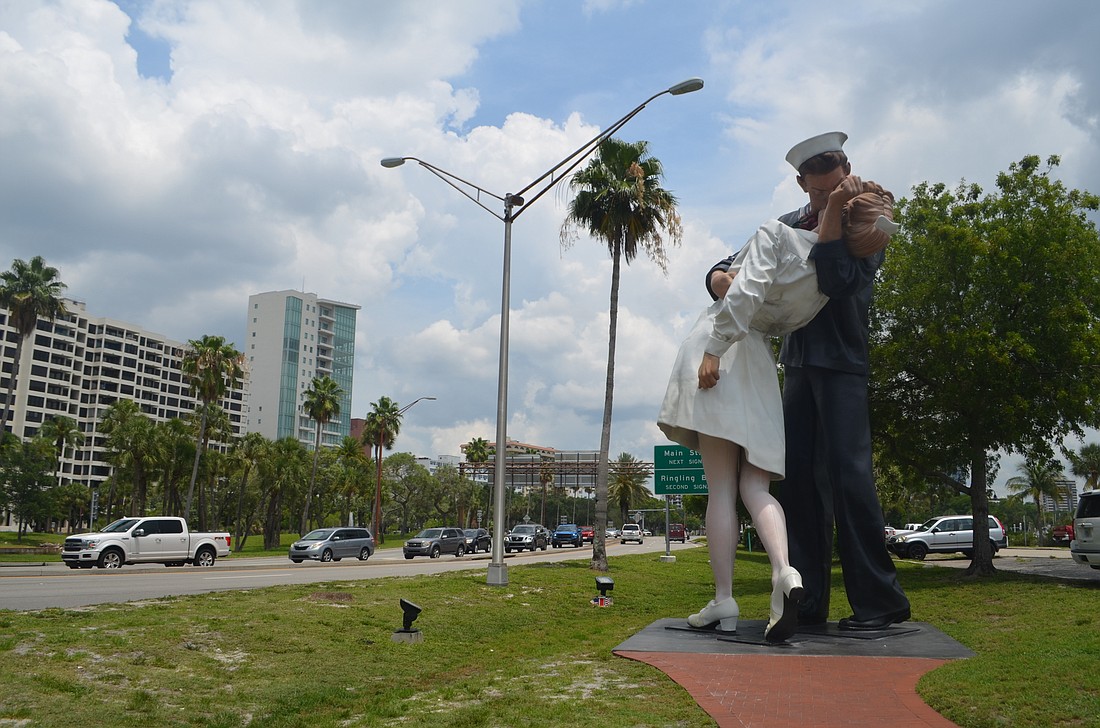- April 18, 2024
-
-
Loading

Loading

For the first time in a decade, city officials have control over the placement of the Unconditional Surrender statue that has become an iconic landmark on Sarasota’s bayfront.
When the city accepted the “kissing sailor” artwork as a donation in 2009, a loan agreement mandated the statue remain in a prominent position near the water for 10 years, accessible to pedestrians and visible to traffic.
That period is now over, and the city can do what it wishes with Unconditional Surrender. The statue will likely be on the move later this year: At Monday’s City Commission meeting, the board agreed with staff’s recommendation to place the artwork in storage during the construction of a roundabout at the nearby intersection of U.S. 41 and Gulfstream Avenue. The project is expected to begin in early 2021 and take 400 days.
The commission did not have any substantive discussion on the long-term placement of Unconditional Surrender and referred the topic to the advisory Public Art Committee.
Although the statue has become a popular destination and was accepted by city officials who saw it as a tribute to Sarasota’s veterans community, it was the source of controversy when donor Jack Curran first proposed the loan. The Public Art Committee unanimously recommended against accepting the statue in 2009, and the City Commission approved the donation in a 3-2 vote.
Some who criticized Unconditional Surrender more than a decade ago remain opposed to its prominent placement on public land. That includes Kafi Benz, president of the Sarasota County Council of Neighborhood Associations. She raised a series of issues with the artwork, most significantly its depiction of a reportedly nonconsensual kiss during a World War II victory celebration.
Unconditional Surrender is based on the famous photograph V-J Day in Times Square, taken by Alfred Eisenstaedt and published in Life magazine in 1945. The woman in the photo, Greta Zimmer Friedman, said in a 2005 interview that it was not her choice to be kissed and that the sailor, a stranger, grabbed her. Benz pointed to other images of the Times Square scene Eisenstaedt captured, which show Friedman balling her fist and pulling at her skirt.
Benz said she believed romanticizing the kiss was contrary to modern cultural values, and she still thinks Unconditional Surrender is an inappropriate piece of public art.
“The situation is abhorrent to me, and it should be to anybody that cares about violence against women,” Benz said.
Terry Turner, a former city commissioner who cast a vote against accepting the donation, said he believes all of the issues raised 10 years ago remain relevant. But although he doesn’t know if the bayfront is the best location for the artwork, he said there’s no denying people have embraced the statue’s presence.
“My observation is that it seems to be enormously popular with tourists,” Turner said.
Unconditional Surrender also has vocal, passionate defenders. Thomas Savage is the founder and director of Sarasota Public Art Fund, which maintained Unconditional Surrender during the loan period. At Monday’s commission meeting, Savage disputed the characterization of the artwork as controversial and described those who have been documented in the press criticizing the statue as “some sourpuss” unduly amplified by media coverage.
Savage said he agreed with those who find the action on the part of the sailor depicted in the photo and statue unacceptable. But he also said that in interviews, Friedman said she did not feel violated by the kiss and instead framed it in the context of post-war celebration.
Savage said the popularity of the statue was undisputed, and although there were some who opposed the original donation, others came out in force to encourage the city to place the artwork where it stands today.
“The greatest group that supports Unconditional Surrender is our veterans,” Savage said. “By the hundreds, they were present for the dedication of the statue. They filled the chamber council with over 200 people to show their support, and I think it’s very important we recognize their presence with the continued presence of Unconditional Surrender in the city.”
Although the statue could be headed into storage for 18 months during the roundabout construction, one commissioner signaled his support for continuing to feature Unconditional Surrender once the project is complete.
“I do think the city should retain ownership and keep it displayed prominently,” Commissioner Hagen Brody said. “It’s a very popular piece, and it really just pays homage to the greatest generation.”